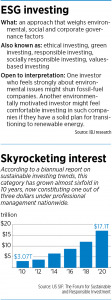Subscriber Benefit
As a subscriber you can listen to articles at work, in the car, or while you work out. Subscribe NowWhether it was divesting from South Africa or avoiding tobacco or firearms companies, socially conscious investing used to take an exclusionary approach.
The concept has evolved into something much more complex, offering investors numerous ways to consider environmental, social and governance issues, or ESG for short, as part of their investment strategy.
By considering factors that go beyond the bottom line, financial experts say, ESG investing can help investors avoid risk without sacrificing returns.
It’s a strategy that’s gaining a lot of attention from investors, and analysts—as well as the companies that hope to attract them.
“In general, more people are aware of a lot of those [ESG] issues, and they’re realizing they can apply some of their views on the investing side,” said John Shelbourne, a financial adviser at Indianapolis-based investment firm Woodley Farra Manion Portfolio Management.
The approach now known as ESG investing has been around for decades, but it started to take off in Europe and the United States in late 2018 and early 2019, said Leon Saunders Calvert, who is based in London and runs financial data company Refinitiv’s sustainable investing, Lipper and I&A Insights businesses.
“There’s been a massive rise in ESG investing over the past few years,” Calvert said. “The U.S. is behind today in relation to Europe, but it’s playing catch-up extremely fast.”
According to US SIF: The Forum for Sustainable and Responsible Investment, at the beginning of 2020, $17.1 trillion—a third of U.S. assets under professional management—used ESG criteria to guide investment decisions. That figure is up 42% from 2018, when ESG investments totaled $12 trillion.
Other organizations cite different figures. The Organisation for Economic Cooperation and Development, a Paris-based international organization that includes the United States as a member country, says a fifth of professionally managed U.S. assets are invested using ESG principles.
It can be tricky to quantify just how big the phenomenon is, largely because ESG investing means different things to different people, and investors can use the strategy for different reasons.
The list of potential ESG categories can include everything from the diversity of a company’s board to its carbon footprint, its workplace-safety record and its involvement in the communities where it operates.
Likewise, investors might use ESG investing to effect social change, as a way to manage risk, or in hopes of achieving improved returns.
“There is no definitive one answer to what ESG or sustainable investing is,” Calvert said.
The types of ESG funds available to investors are also diverse.
“It’s not difficult, really, to find good investment options within those realms,” said Susan Elser, president of Indianapolis-based Elser Financial Planning Inc.
Elser said only about 5% of her clients use ESG investing, but interest has grown over the past eight years or so.
She noticed the trend gaining traction following the Sandy Hook school shooting in 2012. After that crime, which left 20 Connecticut children and six school employees dead, a few of Elser’s clients said they wanted to avoid all investments in companies that produce weapons.
 Investors who want to avoid certain industries can choose an exclusionary fund—but other types of ESG funds include thematic ones built around a certain topic such as green energy or women-run businesses. Best-in-class funds focus on companies considered the best in their industry based on ESG metrics.
Investors who want to avoid certain industries can choose an exclusionary fund—but other types of ESG funds include thematic ones built around a certain topic such as green energy or women-run businesses. Best-in-class funds focus on companies considered the best in their industry based on ESG metrics.
So, for instance, a fossil-fuels company might not make the cut in an exclusionary or thematic fund. But if the company has a solid plan for transitioning from fossil fuels to renewable energy, it might be included in a best-in-class ESG fund.
In years past, Shelbourne said, socially conscious investment funds generally underperformed because they took an exclusionary approach. An investor who shunned fossil-fuels companies, for example, wouldn’t profit from oil boom cycles. But now that ESG has become more holistic, the strategy can help minimize risk.
In the age of climate change and increasing environmental regulations, that fossil-fuels company with a plan to branch into renewable energy is likely to be better positioned for the future than a company with no such plan.
“These environmental and social factors are no longer seen as separate from the financial world,” Calvert said.
But it’s difficult to say whether modern ESG funds are outperformers or laggards, Shelbourne said. “There’s such a broad definition [of ESG] that it’s hard to pin down that answer.”
As investors turn to ESG strategies, the companies hoping to attract those investors are taking notice.
Last year, for instance, Indiana’s publicly held companies mentioned the term “ESG” in public filings 66 times, up from 14 in 2019.
Those companies include Indianapolis-based Allison Transmission Inc., which announced in its 2020 shareholder proxy statement that it was forming a multi-departmental committee to oversee the company’s ESG policies, initiatives and reporting.
“We believe that sound corporate citizenship and attention to governance and environmental principles are essential to our success and creating long-term value for our stockholders,” the company said in the proxy statement.
Among other examples:
Indianapolis-based Kite Realty Group Trust adopted an ESG policy and formed an ESG task force last year, headed by Chairman and CEO John Kite. In July, the company announced it had filed its first assessment with the Global Real Estate Sustainability Benchmark, a standard for ESG benchmarking and reporting in the real estate industry.
Jasper-based Kimball Electronics Inc. released its first-ever ESG report in December, following up with a second report last month.
Reports of this nature don’t just show a company’s ethical values—they’re a way to attract ESG-minded investors, said Amrou Awaysheh, an assistant professor of operations management at Indiana University’s Kelley School of Business at IUPUI. “It’s not the ethical or moral issue. It’s the business case.”
That said, it can be difficult to get a true read on a company’s ESG activities because, at least for now, companies self-report this information and there’s no uniform standard for comparing companies on ESG metrics.
One concern in particular is so-called greenwashing—the possibility that a company might spin its activities to make them look more environmentally friendly than they actually are, or report environmental plans and activities but not actually carry them out.
Awaysheh predicted that reporting on companies’ ESG activities will become more standard as the ESG trend matures.
Despite the current limitations of the data, Awaysheh said, there is still value in companies’ reporting their ESG activities. “At least they’re talking about it and they’re looking at it.”•
Please enable JavaScript to view this content.




